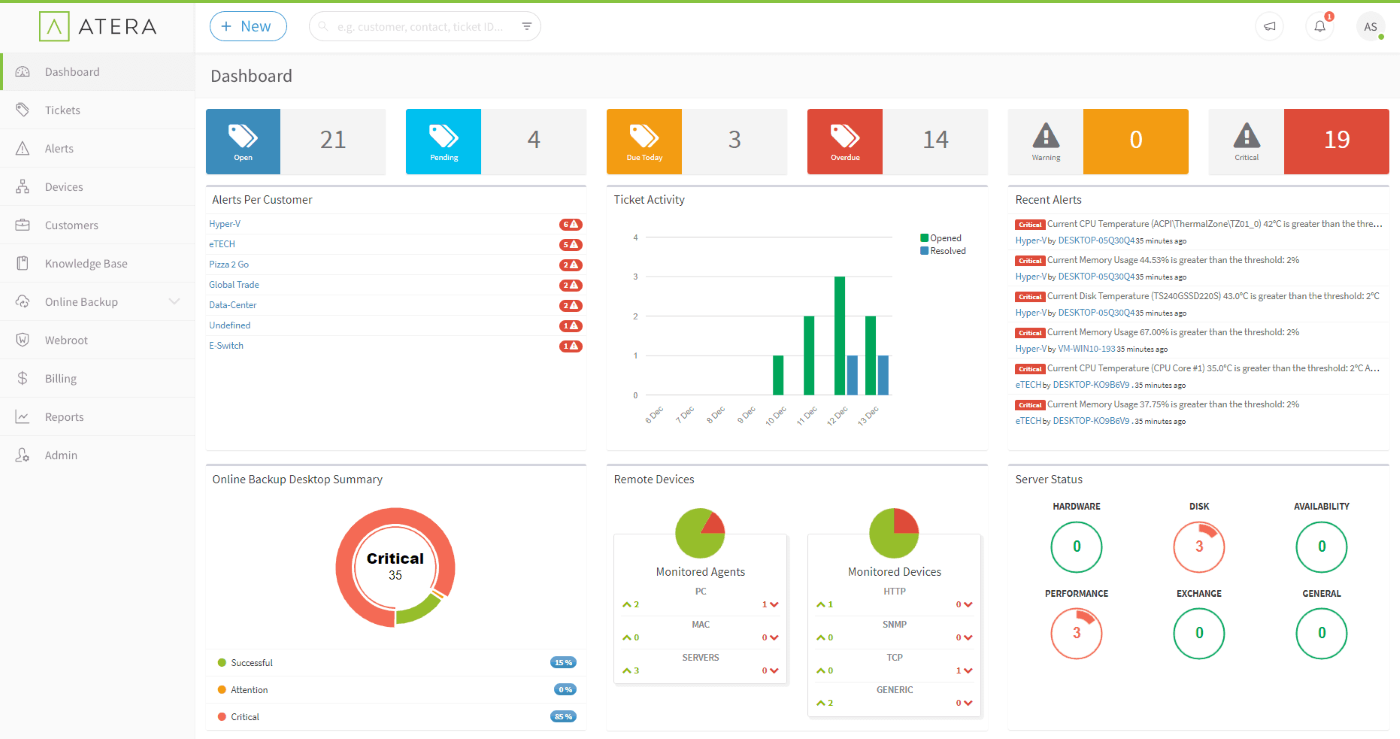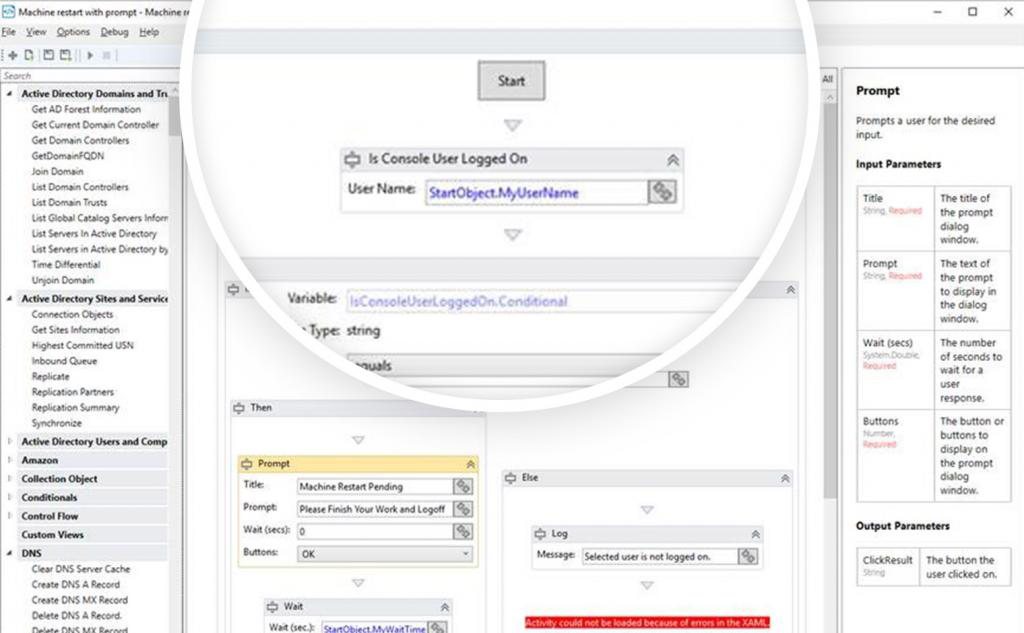What is RMM?
Remote monitoring and management (RMM) is the practice of installing local software on devices so that IT can observe and operate them from another location when necessary. With multi-location businesses or organizations with a lot of remote workers, the IT team may be located in the central headquarters or work from home. However, they still need the ability to troubleshoot problems for other employees, and RMM software allows them to access other devices remotely, so they can identify and fix the problem. MSPs can cut down on their travel expenses and offer better rates to customers if they don’t have to travel to their client’s office to fix a problem.With more employees working remotely than ever before, it can be difficult for IT to perform regular maintenance and updates while also providing support. Plus, more companies are turning to managed services providers (MSPs) as they struggle to find the internal IT resources they need. IT professionals can no longer just pop down to the employee’s office to see what the problem is and fix it onsite. Instead, they have to use remote monitoring and management (RMM) tools to handle support and maintenance from afar.
Looking for the right RMM software for your business? This guide contains everything you need to know about RMM, including key features, benefits, and product comparisons.Find your new RMM software
Compare the best RMM tools
 Atera
Atera |
yes | yes | yes |
 Barracuda RMM
Barracuda RMM |
no | yes | yes |
 ConnectWise Automate
ConnectWise Automate |
yes | no | no |
 Kaseya VSA
Kaseya VSA |
yes | yes | no |
 N-able RMM
N-able RMM |
yes | yes | no |
 NinjaOne
NinjaOne |
yes | yes | yes |
| Product | Asset Tracking | Remote IT Support Tool | Security Assessment |
|---|
Atera
 Atera RMM provides real-time visibility into resource usage, which users are logged on, any updates that need to be installed, and more. Automated tasks include vulnerability scans, patch and update checks, and deleting temporary files. The patch management features allows users to install Windows, Java, Adobe, and Driver updates, even restarting the computer if necessary. With Atera, IT gets advanced control over devices, including the ability to uninstall applications and run scripts.
Atera RMM provides real-time visibility into resource usage, which users are logged on, any updates that need to be installed, and more. Automated tasks include vulnerability scans, patch and update checks, and deleting temporary files. The patch management features allows users to install Windows, Java, Adobe, and Driver updates, even restarting the computer if necessary. With Atera, IT gets advanced control over devices, including the ability to uninstall applications and run scripts.
Barracuda RMM
 Barracuda RMM includes a built-in security assessment tool that allows IT or an MSP to analyze the network and identify vulnerabilities and recommend improvements. There are over 200 pre-built scripts that organizations can use to automate routine tasks and begin remediation for threats. With a remote support tool and professional services automation (PSA) ticketing, your IT team can solve issues quickly and get employee devices back to normal. MSPs also get the option to create different levels of service plans to cater to their customers.
Barracuda RMM includes a built-in security assessment tool that allows IT or an MSP to analyze the network and identify vulnerabilities and recommend improvements. There are over 200 pre-built scripts that organizations can use to automate routine tasks and begin remediation for threats. With a remote support tool and professional services automation (PSA) ticketing, your IT team can solve issues quickly and get employee devices back to normal. MSPs also get the option to create different levels of service plans to cater to their customers.
Connectwise Automate
 ConnectWise Automate is an RMM solution that offers out-of-the-box scripts and automation capabilities to streamline workflows and increase security as soon as it’s implemented. The Asset Discovery feature automatically identifies new devices that connect to the network and tracks their behavior to identify a threat quickly. And with remote monitoring, IT and MSPs can resolve bottlenecks and application performance issues before users even realize there’s a problem.
ConnectWise Automate is an RMM solution that offers out-of-the-box scripts and automation capabilities to streamline workflows and increase security as soon as it’s implemented. The Asset Discovery feature automatically identifies new devices that connect to the network and tracks their behavior to identify a threat quickly. And with remote monitoring, IT and MSPs can resolve bottlenecks and application performance issues before users even realize there’s a problem.
Kaseya VSA
 Kaseya VSA is an RMM tool that provides live, remote control sessions where IT can access the user’s device and work with them to solve issues quickly. Users can also get reports on remote control sessions that include a history of access to maintain compliance and audit trails. The system supports multiple monitors, making it easier for IT teams to see more information at once, and it provides information on connection strength to reduce latency.
Kaseya VSA is an RMM tool that provides live, remote control sessions where IT can access the user’s device and work with them to solve issues quickly. Users can also get reports on remote control sessions that include a history of access to maintain compliance and audit trails. The system supports multiple monitors, making it easier for IT teams to see more information at once, and it provides information on connection strength to reduce latency.
N-able RMM
 N-able RMM provides script-free automation that makes implementation and routine tasks easier. Layered security solutions protect against known and evolving threats, while the dashboard makes it easy to quickly spot anomalies. Third-party patching support is available for a variety of common application types, including Apple, Java, Google, and Adobe. There are several add-on features available, making it easy for businesses to roll out the product slowly and avoid paying for options that they don’t need until later.
N-able RMM provides script-free automation that makes implementation and routine tasks easier. Layered security solutions protect against known and evolving threats, while the dashboard makes it easy to quickly spot anomalies. Third-party patching support is available for a variety of common application types, including Apple, Java, Google, and Adobe. There are several add-on features available, making it easy for businesses to roll out the product slowly and avoid paying for options that they don’t need until later.
NinjaOne
 NinjaOne RMM software is quick to implement, easy to use, and offers low overhead, making it perfect for small businesses and new MSPs. In addition to the typical RMM features, NinjaOne also offers endpoint management for Windows, Mac, Linux, SNMP, or VMWare devices from a single, centralized dashboard. IT teams can create custom alerts and prompt automatic ticket generation to begin remediation quickly. NinjaOne also includes a cloud backup solution to keep files and folders safe.
NinjaOne automates vulnerability remediation, simplifies deployments, and backs up critical business data, while powerful dashboards bring together performance reporting across a company’s managed environments.
NinjaOne RMM software is quick to implement, easy to use, and offers low overhead, making it perfect for small businesses and new MSPs. In addition to the typical RMM features, NinjaOne also offers endpoint management for Windows, Mac, Linux, SNMP, or VMWare devices from a single, centralized dashboard. IT teams can create custom alerts and prompt automatic ticket generation to begin remediation quickly. NinjaOne also includes a cloud backup solution to keep files and folders safe.
NinjaOne automates vulnerability remediation, simplifies deployments, and backs up critical business data, while powerful dashboards bring together performance reporting across a company’s managed environments.
What are the key features of RMM software?
RMM software needs to make it easy for IT to handle routine maintenance, like applying patches, while also staying up to date on the security landscape of the network.Patch management
 Software vendors rollout patches when they discover a vulnerability in their software. Unlike updates which are moderately optional and tend to improve or add new features, companies that don’t apply patches immediately leave themselves open to breaches. Because IT typically handles patching a company’s software, their RMM tool has to include patch management, so they can stay on top of new patches and install them quickly.
Software vendors rollout patches when they discover a vulnerability in their software. Unlike updates which are moderately optional and tend to improve or add new features, companies that don’t apply patches immediately leave themselves open to breaches. Because IT typically handles patching a company’s software, their RMM tool has to include patch management, so they can stay on top of new patches and install them quickly.
Centralized dashboard
 Rather than monitoring each device individually, which would be impossible at large organizations, IT professionals should be able to look at a centralized dashboard through their RMM. The dashboard should show them any patches they need to install, security alerts, and unusual activity, so they can investigate and remediate problems before they become larger issues.
Rather than monitoring each device individually, which would be impossible at large organizations, IT professionals should be able to look at a centralized dashboard through their RMM. The dashboard should show them any patches they need to install, security alerts, and unusual activity, so they can investigate and remediate problems before they become larger issues.
Alerts and reporting
 Companies should also be able to customize their alerts and reporting in their remote monitoring and management solution to prevent false positives and alert fatigue as much as possible. They should have different options for alert delivery, including smartphone notifications that allow IT to respond to threats even when away from their computers. Reports give companies an idea of their overall security health and identify areas where they should improve.
Companies should also be able to customize their alerts and reporting in their remote monitoring and management solution to prevent false positives and alert fatigue as much as possible. They should have different options for alert delivery, including smartphone notifications that allow IT to respond to threats even when away from their computers. Reports give companies an idea of their overall security health and identify areas where they should improve.
Easy deployment
 IT could have to implement RMM software on hundreds of devices, depending on the size of the company, meaning deployment has to be easy in order to be able to roll the solution out in a timely manner. Additionally, getting every employee in the office on the same day is nearly impossible, so RMM software has to be easy to install remotely.
IT could have to implement RMM software on hundreds of devices, depending on the size of the company, meaning deployment has to be easy in order to be able to roll the solution out in a timely manner. Additionally, getting every employee in the office on the same day is nearly impossible, so RMM software has to be easy to install remotely.


